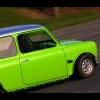Clutch Return Spring
#1

Posted 22 September 2023 - 04:46 AM
So, if my thinking is correct, how strong does the spring have to be? If the spring is too robust, wouldn’t it put unnecessary loading on the clutch hydraulic system and linkage hardware? If so, could I get by using a throttle return spring from the wife’s MG1100?
#2

Posted 22 September 2023 - 06:04 AM
I think that the purpose of the clutch return spring is to prevent premature wear of the clutch throw out bearing by keeping the bearing from constant contact with the clutch diaphragm spring assembly.
So, if my thinking is correct, how strong does the spring have to be? If the spring is too robust, wouldn’t it put unnecessary loading on the clutch hydraulic system and linkage hardware? If so, could I get by using a throttle return spring from the wife’s MG1100?
The clutch arm is pulled against the stop bolt in the clutch housing, thus ensuring the clutch hydraulic mechanism is not under load due to the rreturn spring. The throttle spring may be enough to pull the clutch arm agains the stop, but better to use the correct tension spring, it won't damage the hydraulics because of the stop bolt.
#3

Posted 22 September 2023 - 07:30 AM
I fitted a lighter spring some years back, it might have been a throttle spring.
I can't see that the spring need do more than hold the bearing off the clutch diaphragm when not in use, and even if it were spinning from light contact, it would be for the most part, unloaded, so I can't see it being of any serious detriment.
#4

Posted 22 September 2023 - 07:48 AM
I use a spring that I found digging through parts tins probably 5 years ago and it made the clutch noticeably lighter that my worn out knee popped and cracked less.
If it holds tension against the stop it`s doing its job of giving the trust bearing some free play.....Job done.
#5

Posted 22 September 2023 - 08:17 AM
Throttle return spring is fine.
The 'proper' spring sold by the specialists now is FAR stronger than the original ones ever were, and the only thing that makes for is hassle fitting the damned thing!
#6

Posted 22 September 2023 - 09:05 PM
I use a throttle return spring to avoid injury from trying to fit those stupidly strong springs which are now sold for the job. The strong springs were also causing the hole on the anchor plate to elongate after only a small amount of use.
Edited by unburntfuelinthemorning, 22 September 2023 - 09:06 PM.
#7

Posted 23 September 2023 - 05:53 AM
The clutch arm is pulled against the stop bolt in the clutch housing, thus ensuring the clutch hydraulic mechanism is not under load due to the rreturn spring. The throttle spring may be enough to pull the clutch arm agains the stop, but better to use the correct tension spring, it won't damage the hydraulics because of the stop bolt.
I think that the purpose of the clutch return spring is to prevent premature wear of the clutch throw out bearing by keeping the bearing from constant contact with the clutch diaphragm spring assembly.
So, if my thinking is correct, how strong does the spring have to be? If the spring is too robust, wouldn’t it put unnecessary loading on the clutch hydraulic system and linkage hardware? If so, could I get by using a throttle return spring from the wife’s MG1100?
My concern is that the hydraulic system has to deal with the additional load of an overly strong clutch return spring. The one that is currently installed is from one of the major parts suppliers and removing or installing the thing is a pain. I’m going to give a throttle return spring a try and see what happens. It should lighten the clutch pedal effort.
#8

Posted 23 September 2023 - 06:42 AM
My concern is that the hydraulic system has to deal with the additional load of an overly strong clutch return spring. The one that is currently installed is from one of the major parts suppliers and removing or installing the thing is a pain. I’m going to give a throttle return spring a try and see what happens. It should lighten the clutch pedal effort.
It will add some load but I don't think it will be much for the hydraulic system as it's much more powerful than the spring, for instance the hydraulics can bend the release arm quite easily if things aren't set up right. However for convenience if nothing else a lighter spring makes more sense and doesn't seem to be detrimental in any way. As long as it's doing it's only job of keeping the release bearing from contacting the thrust plate when the clutch is not being operated then job done.
#9

Posted 23 September 2023 - 08:21 AM
The clutch arm is pulled against the stop bolt in the clutch housing, thus ensuring the clutch hydraulic mechanism is not under load due to the rreturn spring. The throttle spring may be enough to pull the clutch arm agains the stop, but better to use the correct tension spring, it won't damage the hydraulics because of the stop bolt.I think that the purpose of the clutch return spring is to prevent premature wear of the clutch throw out bearing by keeping the bearing from constant contact with the clutch diaphragm spring assembly.
So, if my thinking is correct, how strong does the spring have to be? If the spring is too robust, wouldn’t it put unnecessary loading on the clutch hydraulic system and linkage hardware? If so, could I get by using a throttle return spring from the wife’s MG1100?
My concern is that the hydraulic system has to deal with the additional load of an overly strong clutch return spring. The one that is currently installed is from one of the major parts suppliers and removing or installing the thing is a pain. I’m going to give a throttle return spring a try and see what happens. It should lighten the clutch pedal effort.
The clutch return spring has always been hard to fit, right back to the first minis. Personally I find a mole wrench is the only way to fit the spring on my clubman estate and that has an original spring. Compared to the forces needed to move the clutch lever the loads needed to extend the return spring are minimal. Still, If you feel a lesser spring will do the job, go right ahead. Note that the clutch slave cylinder also has a spring in it which must be countered by the clutch return spring.
#10

Posted 23 September 2023 - 11:10 AM
There'll be a bit of centrifugal force when cornering. If you were really fussy you could even make a rough calculation. It'll still be reduced by the spring and only in left hand corners though so would you really need to worry?
A magnet would reduce in force as the distance increased - opposite to the effect from spring tension. ![]()
#11

Posted 28 September 2023 - 01:57 PM
That clutch spring was designed to increase the thigh muscle girth of your left leg! I installed a MiniSpares spring and it was ridiculously too strong; put one end in a vice and gave it a good stretching, now the wife is happy.
#12

Posted 28 September 2023 - 02:29 PM
That clutch spring was designed to increase the thigh muscle girth of your left leg! I installed a MiniSpares spring and it was ridiculously too strong; put one end in a vice and gave it a good stretching, now the wife is happy.
Left leg and the wife is happy, are you Oliver Pistorius? ![]()
One of these, probably either would be good enough:
https://www.minispar...ngs/1E5537.aspx
https://www.minispar...gs/AEC2075.aspx
Edited by ac427, 28 September 2023 - 08:42 PM.
#13

Posted 01 October 2023 - 08:55 PM
I kind of like the strong spring but I agree, it's a royal pain to fit it.
Just in case you don't know - like I did before - there are small hooks that are normally used to install springs in brum brakes etc.
With one of these (a short one) it's quite easy to pull the spring with one hand and guide it into the hole with the other.
Here's an example of what I mean:
https://www.ebay.de/...kp:BFBM-vDwzt1i
#14

Posted 04 October 2023 - 05:38 AM
Edit: Could be my imagination but clutch pedal force seems to be lighter. I like it. We will see how long it lasts.
Edited by croc7, 09 October 2023 - 04:34 AM.
1 user(s) are reading this topic
0 members, 1 guests, 0 anonymous users

















